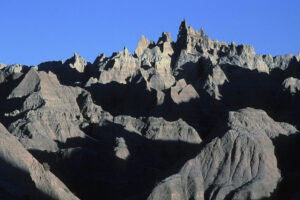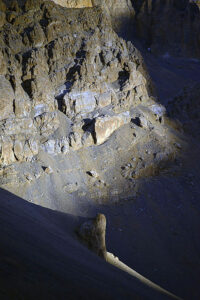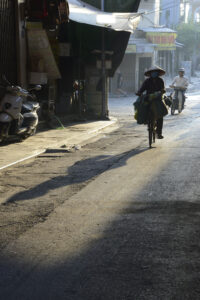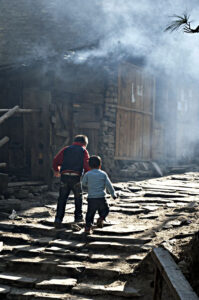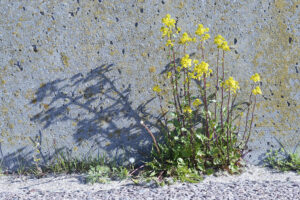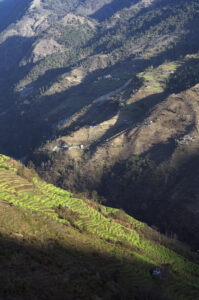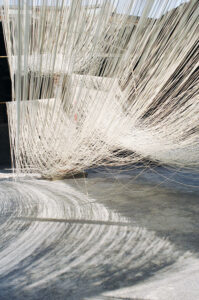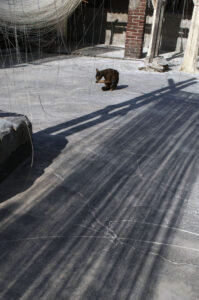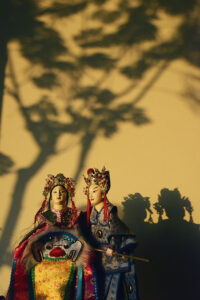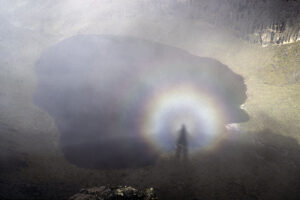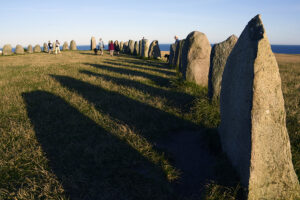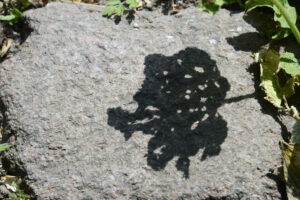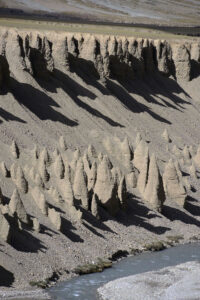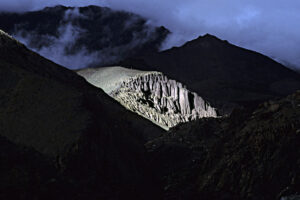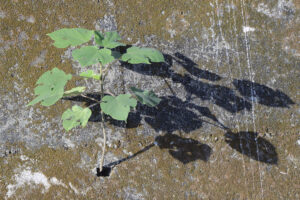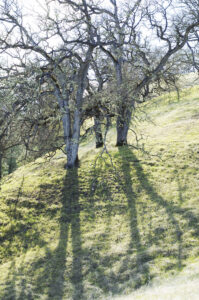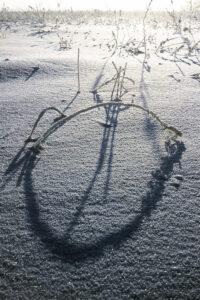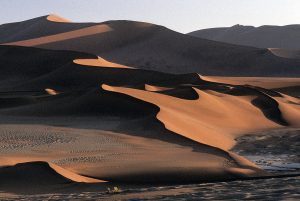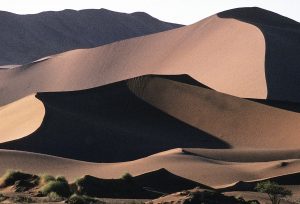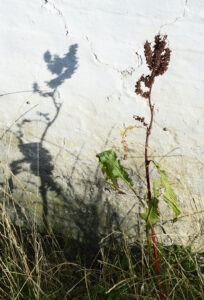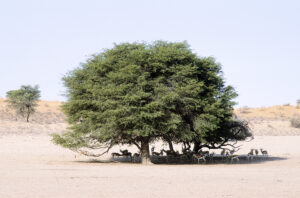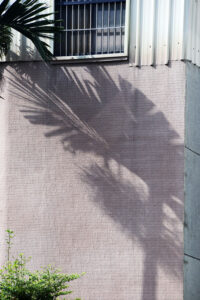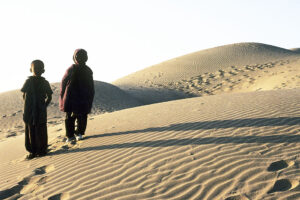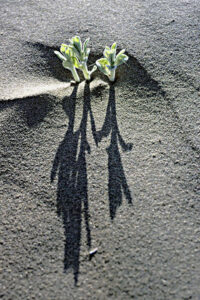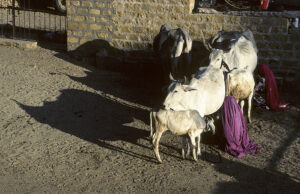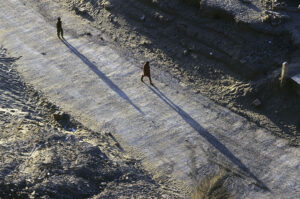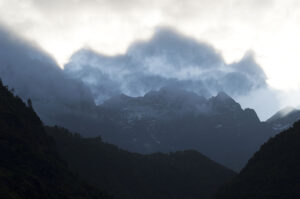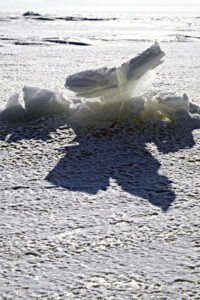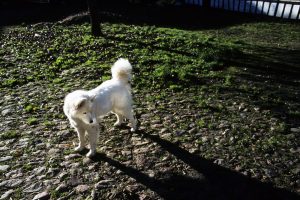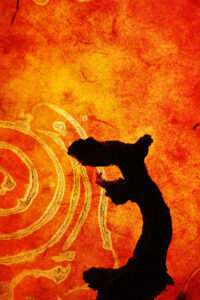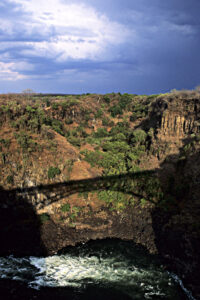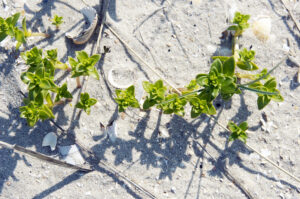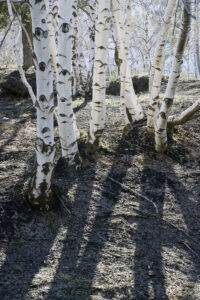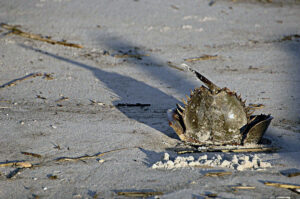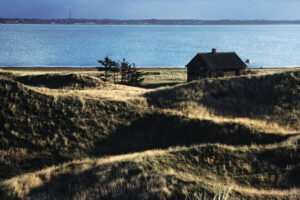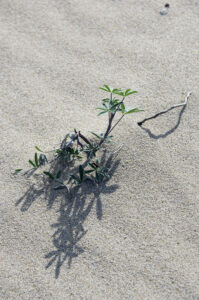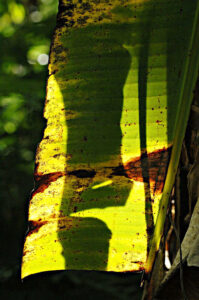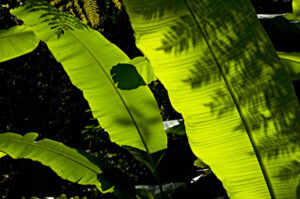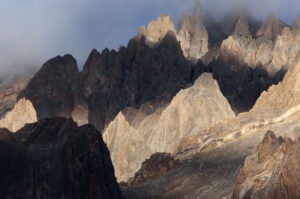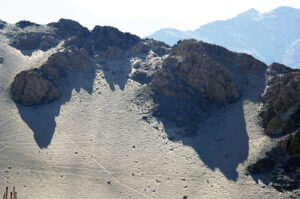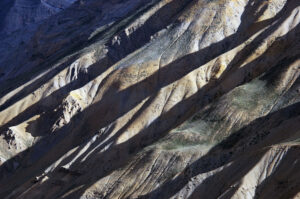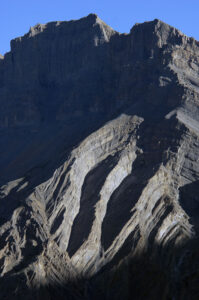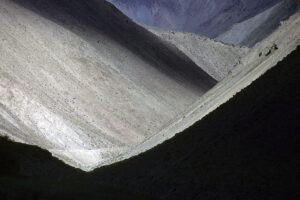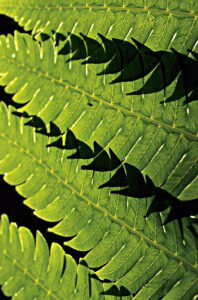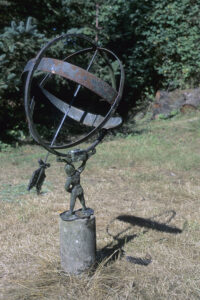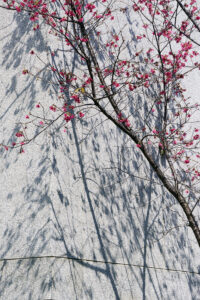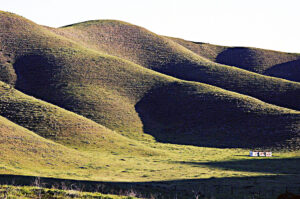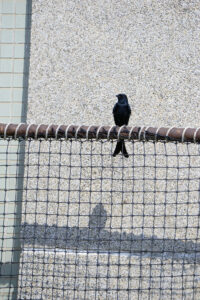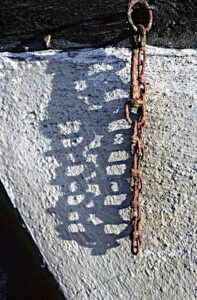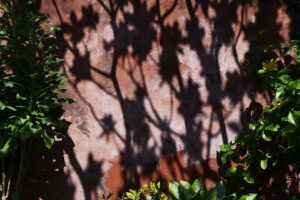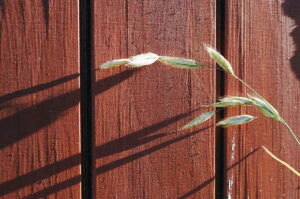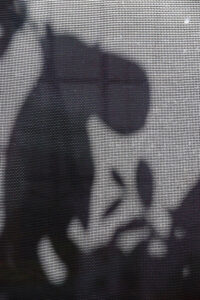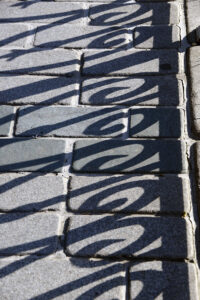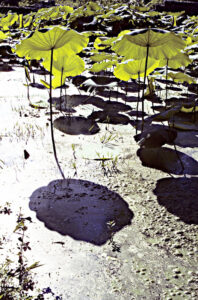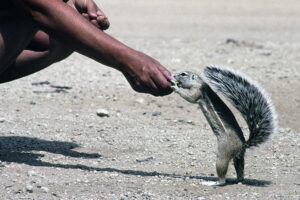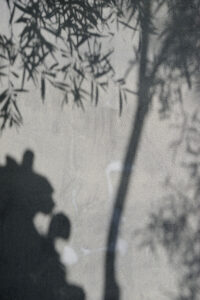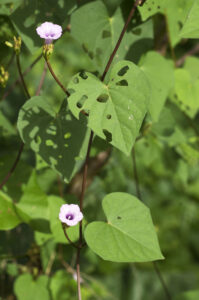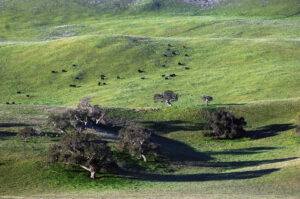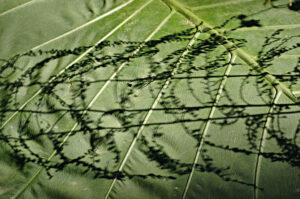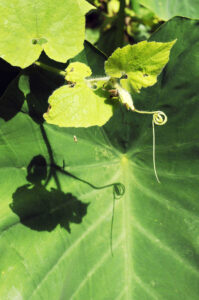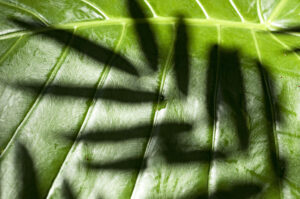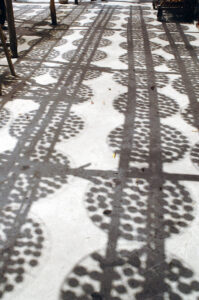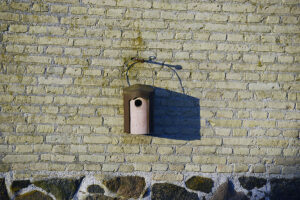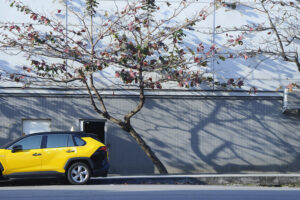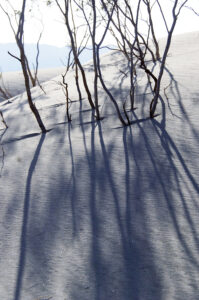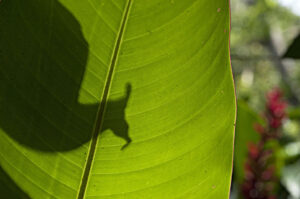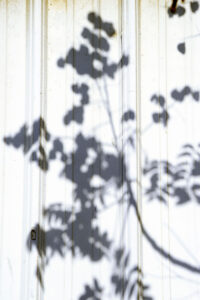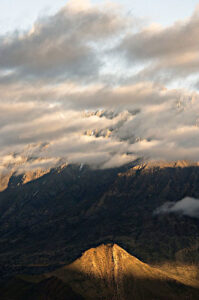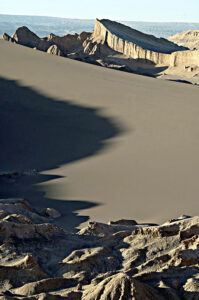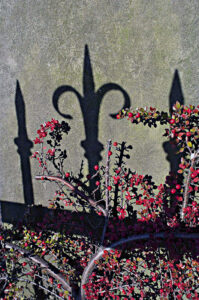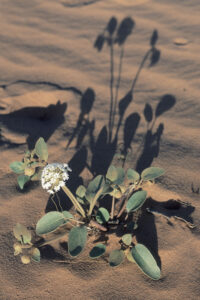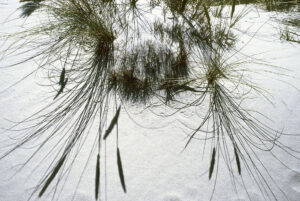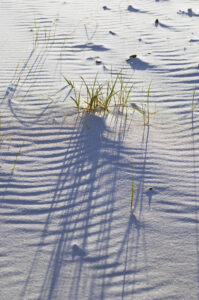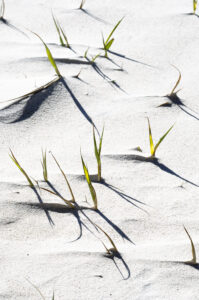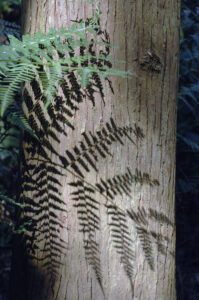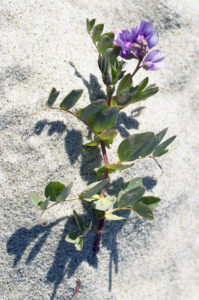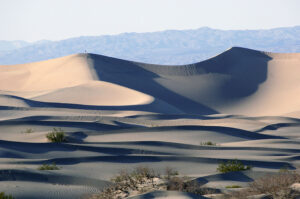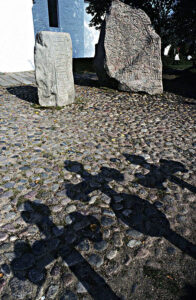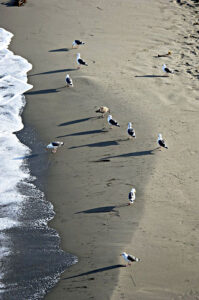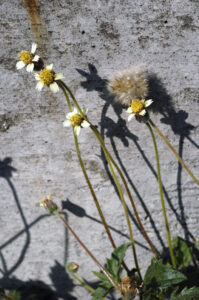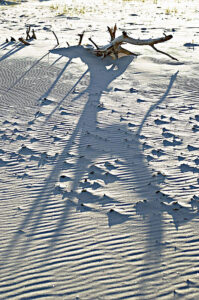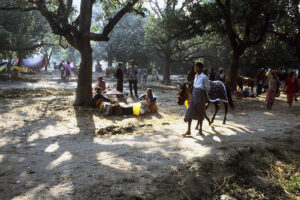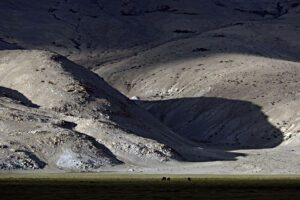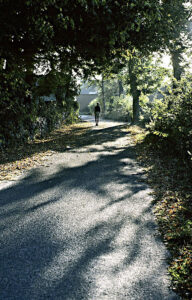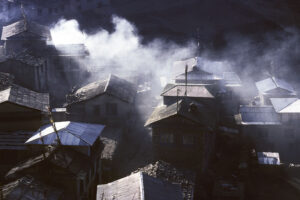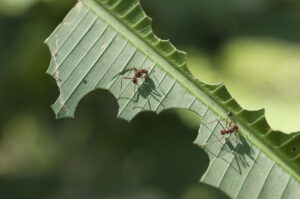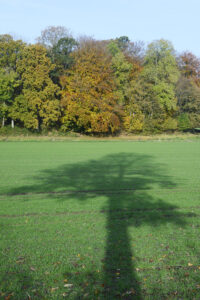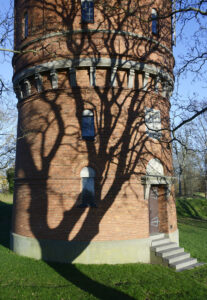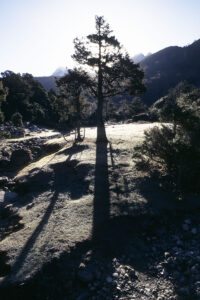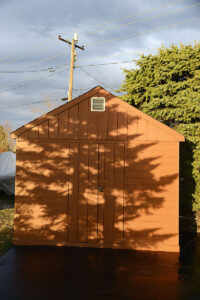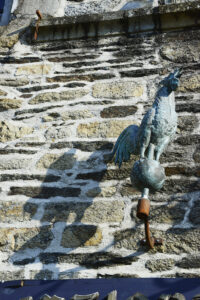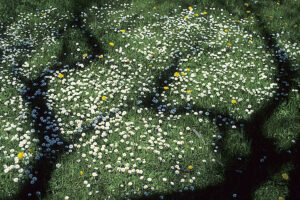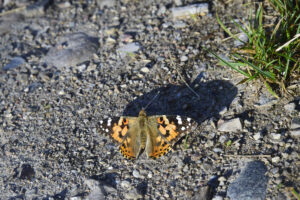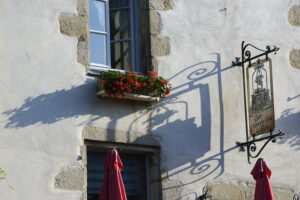Shadows
“In the Land of Mordor where the Shadows lie.” – Eroded rocks in morning light, Badlands National Park, South Dakota, United States (top), and evening light on barren rocks, near Pang, Ladakh, northern India. (Photos copyright © by Kaj Halberg)
Three Rings for the Elven-kings under the Sky,
Seven for the Dwarf-Lords in their Halls of Stone,
Nine for mortal Men, doomed to die,
One for the Dark Lord on his dark Throne,
In the Land of Mordor where the Shadows lie.
One Ring to rule them all, one Ring to find them,
One Ring to bring them all, and in the Darkness bind them,
In the Land of Mordor where the Shadows lie.
From the novel The Lord of the Rings (1954-1955), written by British philologist and author J.R.R. Tolkien (1892-1973). Part of the quote is the inscription on the One Ring – the very ring, which the hobbit Frodo must destroy by throwing it into the fire of Orodruin in Mordor, in order to save the world from Sauron’s wrath.
Young couple, walking hand-in-hand, Xiluo, Taiwan. (Photo copyright © by Kaj Halberg)
Early in the morning, this cyclist in Hanoi, Vietnam, casts a long shadow. (Photo copyright © by Kaj Halberg)
Boys, passing through cooking smoke, seeping out of houses in the village of Chame, Annapurna, Nepal. (Photo copyright © by Kaj Halberg)
Common wintercress (Barbarea vulgaris), also known as yellow rocketcress, winter rocket, or wound rocket, is very common in northern Europe, especially in disturbed places, including abandoned plots, and along roads and railways. This was not always the case, as it was introduced during the 1700s from its native areas in southern Europe, North Africa, and the Near East. It has also been introduced to many other places, including Iceland, North America, and Australia.
The generic name is adapted from a medieval name of the plant, Herba Sanctae Barbarae (’Saint Barbara’s wort’). Holy Barbara was regarded as the patron saint of artillery men and miners, and as wintercress was considered a good healer of wounds, it was named after her.
According to legend, Barbara was the daughter of a rich pagan, living in the 3rd Century. Her father kept her locked up in a tower in order to protect her from the influence of the outside world. However, she secretly became a Christian and rejected to marry the man her father presented to her.
Before going on a journey, her father ordered a private bath-house to be constructed for her near her dwelling, but during his absence, Barbara had three windows put in it, as a symbol of the Holy Trinity, instead of the two originally intended. When her father returned, she informed him that she had become a Christian. He dragged her before the prefect of the province, but, despite being cruelly tortured, she held true to her Christian faith.
At night, her prison was bathed in light, and every morning her wounds were healed. Torches that were held near her to burn her were extinguished. Finally, she was beheaded, and her father himself carried out the death sentence. As punishment, he was struck by lightning and his body consumed by flame.
Barbara was buried by a Christian, and her tomb became the site of miracles. In his book Reisebeschreibung nach Arabien und andern umliegenden Ländern (Gloyer und Oldshausen, Hamburg, 1837, in English Travels Through Arabia and Other Countries in the East, Performed by M. Niebuhr, Gale Ecco, 2018), German cartographer and mathematician Carsten Niebuhr relates that he was shown her grave in the church of the village Karmelis, near Mosul, northern Iraq, in 1766. Some nearby ruins were said to have been her father’s palace.
Common wintercress, casting shadow on a wall, Öland, Sweden. (Photo copyright © by Kaj Halberg)
Light and shadows on terraced fields along the Kimrong Khola Valley, Annapurna, Nepal. (Photo copyright © by Kaj Halberg)
This shadow from leaves, cast on a screen door, resembles Piglet from the book Winnie-the-Pooh (1926), written by English author Alan Alexander Milne (1882-1956), and illustrated by Ernest Howard Shepard (1879-1976). (Photo copyright © by Kaj Halberg)
Drying handmade wheat noodles, Lugang, Taiwan. Other pictures, depicting this process, are shown on the page Plants: Grasses. (Photos copyright © by Kaj Halberg)
The majority of the inhabitants in the Kathmandu Valley, Nepal, are Newars, a people of mixed Caucasian and Mongoloid origin. This picture shows a lane in the Newar village of Bungamati. (Photo copyright © by Kaj Halberg)
The interesting Taiwanese marionette puppet opera is described on the page Culture: Folk art of Taiwan.
Yellowish afternoon sunshine casts the shadows from two Taiwanese marionette puppets, and from a tree, onto a wall. (Photo copyright © by Kaj Halberg)
Fog, lifting above Lake Michaelson, Mount Kenya. A halo is seen around my shadow. (Photo copyright © by Kaj Halberg)
Ales Stenar (‘Stones of Ale’) is a megalithic monument from the Bronze Age near the village of Kåseberga, Skåne, Sweden, consisting of about 60 large stones, erected to form a huge ‘ship’, c. 80 m long and 20 m wide.
Pictures, depicting many other types of megaliths, are presented on the page Culture: Megaliths.
Morning sun on Ales Stenar. (Photo copyright © by Kaj Halberg)
Kuremøllen is a beautiful Dutch type windmill, situated near Svaneke, Bornholm, Denmark. It was built in 1861 to grind wheat and other crops, and a bakery was opened at the mill in 1912. The mill stopped working in 1960, whereas the bakery was closed in 1976. The mill was restored back to its original form in 2005, including poles to turn the hat from the ground. However, it is not done by hand, but with the help of a winch.
The shadow of a wing is cast on Kuremøllen. (Photo copyright © by Kaj Halberg)
Part of a wing of an old Dutch type windmill, Langeland, Denmark. (Photo copyright © by Kaj Halberg)
The crucified Christ in front of the cathedral, Quimper, Brittany. (Photo copyright © by Kaj Halberg)
This shadow from a leaf of hollyhock (Alcea rosea) resembles a grinning witch with a large wart under her nose, Funen, Denmark. Several pictures, depicting this species, are shown on the page Plants: Mallows and allies. (Photo copyright © by Kaj Halberg)
In many areas around the globe, cone-shaped pillars are formed in volcanic layers, or in moraine clay or gravel, which was deposited during the last Ice Age.
In dry weather, these layers are hard as stone, but when it rains, it becomes softer and begins to erode away. However, larger rocks were also deposited by the volcanoes and the glaciers, and under such stones the soil is protected from the rain. Over the years, the surrounding soil is eroded away, and beneath the rocks majestic pillars are formed, often rising steeply out of the soil. Such structures are called earth pyramids.
Earth pyramids and shadows, Niki La, Ladakh, northern India. (Photos copyright © by Kaj Halberg)
Evening sunshine, illuminating earth pyramids in the Markha Valley, Ladakh. (Photo copyright © by Kaj Halberg)
Late in the afternoon, Judy and I cast long shadows, while I photograph the fantastic earth pyramids at Zelve, Göreme, central Turkey. Other pictures, depicting these pyramids, are shown on the page Nature: Rocks and boulders. (Photo copyright © by Kaj Halberg)
Paper mulberry (Broussonetia papyrifera) is described in depth on the pages Plants: Urban plant life, and Nature: Invasive species.
This paper mulberry has sprouted in a small hole in a concrete wall along a drainage canal, Taichung, Taiwan. (Photo copyright © by Kaj Halberg)
Balanced Rock, at North Salem, New York State, is a pre-Columbian dolmen, consisting of a 90-ton granite boulder, which is balancing atop several slabs of granular quartz. Geologists have labeled it an accidental glacial erratic, but it sits precisely over a major magnetic anomaly, and brilliant golf-ball sized lights have repeatedly been photographed circling it.
Such structures show links with electro-magnetic energies and increased crop production. This interesting theory, which was proposed by my late friend John Burke, is described in depth on the page Book – Seed of Knowledge, Stone of Plenty: Understanding the Lost Technology of the Ancient Megalith-Builders.
Balanced Rock is balancing atop several slabs of granular quartz. (Photo copyright © by Kaj Halberg)
Tongariro National Park is situated in the southern part of the North Island of New Zealand, centered around three active volcanoes, Ruapehu (2797 m), Ngauruhoe (2291 m), and Tongariro (1978 m). This park, which covers 786 km2, was established as early as 1887, thus being among the oldest national parks in the world. For the major part of the year, the higher areas of the park are covered in snow.
In fact, Ruapehu is a name that includes a number of peaks, of which the tallest is Tahurangi (2797 m), whereas a striking pointed peak is Girdlestone (2658 m). Initially, this mountain was named Little Matterhorn Peak by Hubert Earle Girdlestone (1879-1918), a New Zealand explorer and war hero, who was killed in France in 1918. His friends installed a plaque on the mountain in 1922, renaming it Girdlestone Peak.
Shadows on snow, Mt. Ruapehu. (Photo copyright © by Kaj Halberg)
The blue oak (Quercus douglasii), sometimes called mountain oak or iron oak, is endemic to California. It is common in the foothills of the Sierra Mountains, and also in the Coast Ranges. It was named for its blue-green foliage.
The specific name was given in honour of Scottish gardener and botanist David Douglas (1799-1834), who explored the North American flora during three expeditions. He introduced Douglas-fir (Pseudotsuga menziesii) and other conifers, especially pine species, as well as a number of bushes and herbs, into British cultivation. In a letter to Sir William Jackson Hooker (1785-1865), director of the Botanical Gardens of Glasgow University, he wrote, “You will begin to think I manufacture pines at my pleasure.”
Douglas died under mysterious circumstances while climbing Mauna Kea in Hawaii in 1834. Apparently, he fell into a pit trap and was possibly crushed by a bull that fell into the same trap. He was last seen at the hut of Englishman Edward ‘Ned’ Gurney, a bullock hunter and escaped convict. Gurney was suspected in Douglas’s death, as Douglas was said to have been carrying more money than Gurney subsequently delivered with the body. (Source: Nisbet, J. 2009. The Collector: David Douglas and the Natural History of the Northwest. Sasquatch Books)
Grassland with open forest of blue oak, Cache Creek Wilderness Area, central California. (Photo copyright © by Kaj Halberg)
Rosebay willow-herb (Chamerion angustifolium) is a colonizer of disturbed areas, readily invading forests clearings and abandoned fields. An excellent example of its ability to completely take over newly abandoned fields is described on the page Nature Reserve Vorsø: Expanding wilderness.
The stem of this rosebay willow-herb is covered in rime, bending it to the ground, Nature Reserve Vorsø, Jutland, Denmark. (Photo copyright © by Kaj Halberg)
Chortens are the Tibetan variety of Buddhist stupas, whose various parts symbolize the elements, the base representing soil, the dome water, the rings or squares above the dome fire, and the crescent moon air, whereas the uppermost point, sometimes depicted as a small sun, represents outer space.
Chortens and other Buddhist structures are dealt with in depth on the page Religion: Buddhism.
Early in the morning, this chorten stands out against the barren hills surrounding Tso Kar, a saline lake in Ladakh, northern India. (Photo copyright © by Kaj Halberg)
Decayed chortens, near Leh, Ladakh. (Photo copyright © by Kaj Halberg)
Field bindweed (Convolvulus arvensis) is a Eurasian species, which twines around other plants to compete for sunlight and nutrients.
In America, popular names of this species include Creeping Jenny, alluding to its invasive nature. In his delightful book All about Weeds, American botanist Edwin Spencer (1881-1964) writes: “Creeping Jenny is one of the meanest of weeds. That name aptly describes it. A whispering little hussy that creeps in and spoils everything. The weed needs no other name than this, but it has several others (…) hedge bells, corn-lily, withwind, bellbine, lap-love, sheep-bine, corn-bind, bear-bind, and green vine.”
Many other members of the morning-glory family are presented on the page Plants: Morning-glories and bindweeds.
In this picture from Zealand, Denmark, the shadow from leaves of a field bindweed is cast on a leaf of garden nasturtium (Tropaeolum majus), resembling two pairs of Disney’s Aristocats. (Photo copyright © by Kaj Halberg)
In the Namib Desert, western Namibia, an area around Sossusvlei holds a large number of reddish sand dunes, some of which are about 275 m tall. These dunes and other natural phenomena in Namibia are described on the page Countries and places: Namibia – a desert country.
Late afternoon light on sand dunes at Sossusvlei, Namib Desert. (Photos copyright © by Kaj Halberg)
The genus Artocarpus, popularly called breadfruit, contains about 60 species of trees and shrubs, belonging to the fig family (Moraceae), the major part of which are indigenous to Southeast Asia, a few to islands in the Pacific. The numerous flowers grow into a so-called syncarpous fruit, i.e. a fruit with numerous carpels, packed closely together. In many species, the fruit can grow very large.
The generic name is derived from the Greek artos (‘bread’) and karpos (‘fruit’), a name given by Scottish-German botanist Johann Reinhold Forster (1729-1798) and his son Johann Georg Forster (1754-1794), who participated as botanists during the second voyage of James Cook (1728-1779), which took place 1772-1775.
Some species are widely cultivated, especially common breadfruit (Artocarpus altilis) and jackfruit (A. heterophyllus). The latter is described in detail on the pages Travel episodes – Sri Lanka 1976: Among alcohol brewers, and Nature: Nature’s patterns.
The shadow from a leaf of common breadfruit tree is cast on another leaf, Taichung, Taiwan. (Photo copyright © by Kaj Halberg)
Street sweeper, Karapinar, east of Konya, Turkey. (Photo copyright © by Kaj Halberg)
It is generally believed that the curly dock (Rumex crispus) originated in Europe, but today it is found in almost all corners of the globe. It was originally a coastal plant, but with the introduction of agriculture, it quickly spread to the fields, where it is still today a noxious weed. A single plant can produce more than 5,000 seeds, which keep the faculty of germination for a long time. They also pass unharmed through the intestines of cattle and may thus be spread to fields with the manure.
Curly dock, casting its shadow on a barn wall, Funen, Denmark. (Photo copyright © by Kaj Halberg)
When the Boer (Dutch immigrants) arrived in South Africa in the 18th Century, they noticed a species of antelope, which would often jump about, obviously for sheer pleasure. For this reason, they named it springbok (’jumping buck’). This behaviour is called pronking, where an animal, on stiff legs, leaps several times into the air, sometimes as much as 2 m above the ground, arching its back and raising a pocket-like, white skin flap, which extends from the tail along the midline of the back.
The scientific name of this animal, Antidorcas marsupialis, is derived from Ancient Greek anti (‘opposite’) and dorkas (‘gazelle’), indicating that it is not a true gazelle, and from the Latin marsupium (‘pocket’), alluding to the skin flap on the back. Another difference from the gazelles is that its horns are either straight, or with the tips curving slightly forward, whereas those of the gazelles usually curve backward in an arch.
The springbok lives in dry areas of south-western Africa, from extreme southern Angola southwards through Namibia and western Botswana to western South Africa. It is the national animal of South Africa.
In the intense midday heat in Kalahari Gemsbok National Park, South Africa, these springbuck have sought shelter in the shade from a tree. Research has shown that the temperature around noon in shady places may be up to 30 degrees lower than places exposed to the sun. (Photo copyright © by Kaj Halberg)
Gate and late afternoon shadow, Eriksberg Stränder Nature Reserve, Blekinge, Sweden. (Photo copyright © by Kaj Halberg)
The areca palm, or betel palm (Areca catechu), has given name to the entire palm family (Arecaceae). The generic name is derived from a local South Indian name of the tree, either from the Tamil areec, or from the Malayalam atekka. The specific name is derived from a Malayan name of the plant, caccu.
It is believed to have originated in the Philippines, but is widely cultivated elsewhere in tropical and subtropical areas of Asia, in New Guinea and the West Indies, and on many Pacific Ocean islands.
Its nut is an ingredient in betel, a mild intoxicant, consisting of a leaf from the betel bush (Piper betle), which is wrapped around bits of areca nut and, according to your taste, tobacco or spices, taken with a small amount of lime. Chewing this mixture increases your spit production, and your saliva turns brick-red. Blotches of betel spit are ubiquitous in many Asian countries – on streets, house walls, stairs, and elsewhere.
Leaves of areca palms, casting shadows on a house wall, Taichung, Taiwan. The species is cultivated by the millions in Taiwan, as about every other man is chewing the intoxicant. (Photos copyright © by Kaj Halberg)
The vast Thar Desert stretches across the state of Rajasthan, north-western India, and further west into Pakistan. The main part of this desert is level sand or gravel plains with scattered bushes and trees, including a cactus-like species of spurge, named thor (Euphorbia caduca), the Sodom apple (Calotropis procera), locally called akaro, and a tree named dzal (Salvadora procera).
The fruit of the Sodom apple was first described by Roman historian Titus Flavius Josephus, born Yosef ben Matityahu (c. 37-100 A.D.), who found it growing near the city of Sodom: “which fruits have a colour as if they were fit to be eaten, but if you pluck them with your hands, they dissolve into smoke and ashes.” (Source: W. Whiston, 1737. The War of the Jews, Book IV, Chapter 8, Sec. 4). Titus is referring to the fact that the ripe fruit easily dissolves, releasing hundreds of downy seeds, which are scattered to the four winds.
The city of Jaisalmer is situated in the heart of the Thar Desert, near the Pakistani border. It was founded in 1155 by Rajput prince Roa Rawal Jaisal, who ordered construction of a huge fort, Sonar Qila – testimony of a time, when unrest reigned in this area. Originally, this fort was surrounded by an outer wall, 4.5 km long, but today the city stretches far beyond the remains of this wall.
This area is described in depth on the pages Travel episodes – India 1986: “Sir, would you like to see this peacock?” and India 2003: Camel safari in the Thar Desert.
Golden sand dunes, up to 50 m high, dominate the landscape here and there in the Thar Desert. (Photo copyright © by Kaj Halberg)
Small plant, casting long shadows on a sand dune, Thar Desert. (Photo copyright © by Kaj Halberg)
Don’t fall down! – This picture was taken during a camel safari in the Thar Desert. Camels are dealt with in detail on the page Animals: Animals as servants of Man. (Photo copyright © by Kaj Halberg)
Early in the morning, these women in Jaisalmer are milking their zebu cows. The calves are waiting for their share. – The zebu ox is described on the page Animals: Animals as servants of Man. (Photo copyright © by Kaj Halberg)
Pedestrians, casting long afternoon shadows, Jaisalmer. (Photo copyright © by Kaj Halberg)
The kauri tree (Agathis australis) is endemic on North Island, New Zealand. This majestic tree was almost eradicated due to the insatiable greed of Man, and today the poor remains of the formerly enormous growths are strictly protected. This species is described in depth on the page Plants: Ancient and huge trees.
This shadow from a species of Astelia, cast on the trunk of a kauri tree in Trouson Kauri Park, resembles a huge centipede. (Photo copyright © by Kaj Halberg)
The shadow from a jagged mountain chain is reflected on clouds, Khumbu, Nepal. (Photo copyright © by Kaj Halberg)
Morning traffic, Taichung, Taiwan. (Photo copyright © by Kaj Halberg)
Ice sculpture, formed around a stone in shallow water, Horsens Fjord, Denmark. Other pictures, depicting such sculptures, are shown on the page Nature: Snow and ice. (Photo copyright © by Kaj Halberg)
The long relationship between the dog and Man is described in detail on the page Animals: Animals as servants of Man.
Late in the afternoon, this woman is walking her dog on a sandy beach near Mendocino, California. (Photo copyright © by Kaj Halberg)
Samoyed, watching its own shadow, Denmark. (Photo copyright © by Kaj Halberg)
Hilly grassland, near Ljosavatn, northern Iceland. (Photo copyright © by Kaj Halberg)
The shadow from this piece of dried ginger, held up in front of a lampshade, resembles a dragon. – Taiwan. (Photo copyright © by Kaj Halberg)
The Victoria Falls Bridge spans the Zambezi River near Victoria Falls. This river constitutes the border between Zimbabwe and Zambia.
Pictures, depicting many other bridges, may be studied on the page Culture: Bridges.
The shadow from Victoria Falls Bridge is reflected on rocks along the river gorge. (Photo copyright © by Kaj Halberg)
The sea sandwort (Honckenya peploides) is a member of the carnation family (Caryophyllaceae), growing on sandy beaches and in outer sea side sand dunes. The many-branched stem is buried beneath the sand, and all you see of the plant is the fleshy, pale green, pointed leaves and the greenish-white flowers with 5 small, rounded petals and 10 stamens. The plant often covers quite large areas.
It was named for German botanist Gerhard August Honckeny (1724-1805), who is best known for his Synopsis Plantarum Germaniæ.
Sea sandwort and its shadow, Fanø, Denmark. (Photo copyright © by Kaj Halberg)
The silver birch (Betula pendula) is described on the page Plants: Ancient and huge trees.
The white bark of silver birches, growing on slopes beneath the Etna volcano, Sicily, is so striking that these trees have often been labelled a separate form, B. pendula ‘aetnensis’. (Photo copyright © by Kaj Halberg)
The Atlantic horseshoe crab (Limulus polyphemus) is widely distributed along the eastern coast of North America, from southern Canada southwards to southern Mexico. These strange animals are described in depth on the page Animals – Invertebrates: Horseshoe crabs – living fossils in peril.
Dead Atlantic horseshoe crab, Reeds Beach, Cape May, New Jersey. (Photo copyright © by Kaj Halberg)
Shady street in the town of Lugang, Taiwan. (Photo copyright © by Kaj Halberg)
Udaipur is a delightful city in southern Rajasthan, India, situated around the gorgeous Pichola Lake. As early as the 10th Century, the Hindu Mewar Rajputs established a town here, named Ayad, which became a thriving trading centre.
Udaipur was founded in 1559 during the reign of Maharana Udai Singh II, the ruler of Chittorgarh, further north. Chittorgarh, situated in a flat tableland, was vulnerable to attacks from the Maharana’s enemies, notably Muslims, who had conquered parts of northern India.
Following the emergence of artillery warfare in the 16th century, Udai Singh decided to move his capital to a more secure location, choosing Ayad. However, as Ayad was prone to flooding, he decided to establish his new capital on a ridge east of Pichola Lake. To protect the new city from attacks, Udai Singh ordered a 6-km-long wall, with seven gates, to be built around the city.
The belligerent Rajputs are described on the page Travel episodes – India 1986: “His name is Muhammed!”
This woman brings a basket of laundry to Lake Pichola, Udaipur. (Photo copyright © by Kaj Halberg)
Entrance gate at the lake. (Photo copyright © by Kaj Halberg)
The distribution area of the tree sparrow (Passer montanus) is huge, from western Europe across Central Asia to Japan, and thence southwards through Southeast Asia to Indonesia and the Philippines. The specific name is Latin, meaning ‘belonging to mountains’, from mons (‘mountain’). An odd name for this bird, which is very common in lowlands.
Other pictures, depicting tree sparrows, may be seen on the pages Animals: Urban animal life, and Animals – Birds: Birds in Taiwan.
A tree sparrow and its shadow, Taichung, Taiwan. (Photo copyright © by Kaj Halberg)
Grass-clad dunes on the island of Langli, Wadden Sea, Jutland, Denmark. (Photo copyright © by Kaj Halberg)
Seashore lupine (Lupinus littoralis) is native to sandy habitats along the coast of western North America, from British Columbia southwards to northern California. It is a small herb or subshrub, growing to about 30 cm tall.
Seashore lupine, growing in a dune, John Dellenback Trail, Oregon Dunes National Recreation Area, Oregon. (Photo copyright © by Kaj Halberg)
A collection of pictures, depicting bananas and banana leaves, are shown on the page Plants: Bananas.
The shadow on this withering banana leaf, observed on the island of Lombok, Indonesia, resembles some gaping creature, wearing a tall hat. Or maybe Mrs. Simpson from the well-known TV series The Simpsons? (Photo copyright © by Kaj Halberg)
As its name implies, the Taiwan banana (Musa formosana) is endemic to Taiwan. This plant, which can grow to 6 m tall, is found on forested slopes from near sea level to an altitude of about 1,000 m.
Shadows from ferns create patterns on leaves of Taiwan banana, Malabang National Forest. (Photo copyright © by Kaj Halberg)
Barren mountains and rocks are a common feature in the dry landscapes Ladakh, Lahaul, and Spiti, northern India, where rain is scarce.
Morning sun on jagged mountains in the Shila River Valley, Ladakh. (Photo copyright © by Kaj Halberg)
Barren slopes near Leh, Ladakh. (Photo copyright © by Kaj Halberg)
Evening light on barren mountains, Spiti. (Photos copyright © by Kaj Halberg)
Barren slopes in the Markha Valley, Ladakh. (Photo copyright © by Kaj Halberg)
The shadows of branches and windows are reflected on a wall, Long Island, United States. (Photo copyright © by Kaj Halberg)
Swedish whitebeam (Sorbus intermedia) is a smallish tree, growing to about 15 m tall. It is a natural hybrid with genes from rowan (S. aucuparia), wild service tree (S. torminalis), and possibly common whitebeam (S. aria).
Swedish whitebeam is most abundant in southern Sweden (hence its common name), and also occurs on scattered locations in Estonia, Latvia, south-western Finland, and northern Poland, and on the Danish island of Bornholm. It is often planted elsewhere, especially along roads.
Shadows from a planted row of Swedish whitebeam, Funen, Denmark. (Photo copyright © by Kaj Halberg)
Fern leaflets, El Yunque, Puerto Rico. (Photo copyright © by Kaj Halberg)
A sundial is a device that shows the time of the day by casting the shadow of a narrow metal stick or the like on a surface, marked with the daylight hours.
Sundial, Jutland, Denmark. (Photo copyright © by Kaj Halberg)
Despite its name, the Taiwanese cherry (Prunus campanulata) is also found in Japan, southern and eastern China, and Vietnam. It is a small tree, growing to 8 m tall.
Due to its gorgeous bell-shaped flowers, this species is widely cultivated. When flowering, its nectar is a very popular food source for many bird species. On the page Animals – Birds: Birds in Taiwan, numerous pictures depict birds feeding in these flowers.
The specific name is Latin, meaning ‘bell-shaped’, referring to the flowers.
Flowering Taiwanese cherry, casting shadow on a wall, Tunghai University Park, Taichung, Taiwan. (Photo copyright © by Kaj Halberg)
Catbriers, also known as greenbriers (Smilax), are a genus with about 260 species of woody climbers, distributed across the globe, except the polar regions and large parts of Europe. Chinese catbrier (Smilax china) is found from China, Korea, and Japan southwards to Indochina, the Malayan Peninsula, and the Philippines, growing in shady forests and shrubberies, often along streams, from sea level up to elevations around 2,000 m.
Chinese catbrier, Basianshan National Forest, Taiwan. (Photo copyright © by Kaj Halberg)
Green hills near Los Alamos, California. (Photo copyright © by Kaj Halberg)
The black drongo (Dicrurus macrocercus) is a common resident in tropical and some subtropical areas of Asia, from southern Iran through the Indian Subcontinent to southern China and Taiwan, and thence southwards to Indonesia. It has also been introduced to certain Pacific islands, where it constitutes a threat to native bird species.
It lives in open areas, where it catches flying insects from a prominent perch, such as an electric wire or a bare branch. As its name implies, the plumage of this species is jet-black, with very little sheen.
The specific name is derived from Ancient Greek macros (‘long’) and kerkos (‘tail’).
Black drongo and its shadow, Taichung, Taiwan. (Photo copyright © by Kaj Halberg)
Rusted chain on a house wall, Lyø, Funen, Denmark. (Photo copyright © by Kaj Halberg)
Red frangipani (Plumeria rubra), also called temple tree, is native to Mexico, Central America, and northernmost South America. Due to its pretty, fragrant flowers, this species has been introduced to almost all tropical and subtropical countries as an ornamental. In Asia, it is often planted near temples, hence one of the popular names.
The shadow from a red frangipani is cast on a wall, surrounding a temple in the city of Tainan, Taiwan, dedicated to Confucius. (Photo copyright © by Kaj Halberg)
Humayun, whose real name was Nasir-ud-Din Muhammad, was the second emperor of the Moghul Empire, comprising what is today north-western India, Pakistan, and Afghanistan. He ruled in two periods, 1531-1540 and 1555-1556. He died in 1556, when he stumbled on the staircase, leading up to his library, hitting his head on the rough stone steps.
The shadow from a carved sandstone ‘window’ creates patterns on a wall in Humayun’s Tomb, Delhi, India. (Photo copyright © by Kaj Halberg)
Soft brome (Bromus hordeaceus) is a grass species, which is native to Europe and northern Asia, and it has also become naturalized in many other places, including North America, where it is known as bull grass or soft cheat.
In this picture, fruiting spikes of soft brome cast long shadows on a fisherman’s shed near Roskilde Fjord, Zealand, Denmark. (Photo copyright © by Kaj Halberg)
Shadows from leaves, cast on a screen door, resemble a Moomin – the well-known figures, created by Swedish author Tove Marika Jansson (1914-2001). – Taichung, Taiwan. (Photo copyright © by Kaj Halberg)
Shadows from a metal fence are cast on flagstones on the Hippodrome Square, Istanbul, Turkey. (Photo copyright © by Kaj Halberg)
The sacred, or Indian, lotus (Nelumbo nucifera) is distributed from Iran and the entire Indian Subcontinent eastwards to southern China, Taiwan, and Japan, thence southwards through Southeast Asia, Malaysia, and Indonesia to New Guinea and northern Australia.
All parts of this plant are edible, in particular the rhizome and seeds. Rhizome, leaves, and seeds are also widely used in traditional Indian and Oriental medicine for treatment of numerous ailments.
This species is sacred to Hindus, Buddhists, Sikhs, and Jains, who call it padma. Its important role in Buddhism and Hinduism is described on the page Plants: Plants in folklore and poetry, whereas the various Indian religions are dealt with on the page Religion.
Lotus leaves, Yangshuo, Guangxi Province, southern China. (Photo copyright © by Kaj Halberg)
The scientific family name of squirrels, Sciuridae, is derived from Sciurus, the name given in 1758 to the Eurasian red squirrel (S. vulgaris) by Swedish naturalist Carl Linnaeus (1707-1778). Sciurus is a Latinized form of the Greek skiouros, meaning ‘shadow-tailed’, from skia (‘shadow’) and oura (‘tail’), alluding to the habit of many squirrels of holding the bushy tail high above the back.
Many squirrel species are presented on the page Animals – Mammals: Squirrels.
In the intense midday heat in the Kalahari Gemsbok National Park, South Africa, this Cape ground-squirrel (Xerus inauris) is using its tail to provide shadow on its body. (Photo copyright © by Kaj Halberg)
Shadows from bamboo, and from leaves of a tree, are cast on the back side of a sign near the Daoist Tzi Gong Da Foa Temple, Linnei, Taiwan. The shadows from the tree leaves resemble a cat, licking its paw. (Photo copyright © by Kaj Halberg)
Ipomoea triloba is a twining member of the morning-glory family (Convolvulaceae), native from Mexico and the Caribbean southwards to northern South America, but today it is widespread in warmer areas around the world, often becoming a noxious weed. It is found in grasslands, shrubberies, waste places, along roads, and occasionally on sandy beaches, from sea-level to elevations around 750 m.
In some areas, the leaves are cooked and eaten as a vegetable. A poultice of the plant is used in treatment of headache, a decoction of the leaves against stomach ache.
It is described in depth on the page Plants: Morning-glories and bindweeds.
Ipomoea triloba, Ubud, Bali, Indonesia. The shadow of a partly eaten leaf is cast on another leaf. (Photo copyright © by Kaj Halberg)
Fire hydrant and its shadow, Taichung, Taiwan. (Photo copyright © by Kaj Halberg)
The domestication of various wild oxen is described on the page Animals: Animals as servants of Man.
Morning light, grazing cattle, and oak trees, near Los Alamos, California. (Photo copyright © by Kaj Halberg)
Late in the afternoon, this ox-cart is casting a long shadow, southern Pakistan. (Photo copyright © by Kaj Halberg)
Grazing cows in evening light, Waitomo, New Zealand. (Photo copyright © by Kaj Halberg)
During the annual November fair, which takes place in the town of Sonpur, Bihar, northern India, this cart, pulled by zebu oxen, casts long morning shadows. (Photo copyright © by Kaj Halberg)
The giant taro, or giant elephant’s ear (Alocasia macrorrhizos), which grows to 5 m tall, is native from Malaysia southwards through Indonesia to northern Australia, but has been introduced to many other tropical and subtropical areas as an ornamental, food crop, or animal feed. It is listed as an invasive species in Cuba and New Zealand, and on several Pacific islands.
The gigantic leaves are often used as umbrellas. The rhizome is edible when cooked for a long time, but the sap irritates the skin in your mouth, as it contains needle-like calcium oxalate crystals.
In Hawaii, this plant is called ʻape, and they have a saying, Ai no i kaʻape he maneʻo no ka nuku. (’The one who eatsʻape, will have an itchy mouth’). This saying is also used figuratively, meaning that ’there will be consequences for partaking of something bad.’ (Source: M.K. Pukui 1986. ‘Ōlelo No’eau, Hawaiian Proverbs and Sayings. Bishop Museum Press, Honolulu)
Shadows from ferns create patterns on a leaf of giant taro, Shei-pa National Park, Taiwan. This species is ubiquitous in the lowland of Taiwan. (Photo copyright © by Kaj Halberg)
A close relative, the fragrant taro, or lesser elephant-ear (Alocasia odora), is native from north-eastern India eastwards to Japan, and thence southwards to Borneo. This species also contains needle-sharp calcium oxalate crystals in its cells. It is inedible when raw, and in Japan, several cases of food poisoning through consumption of this herb have been reported.
In Vietnam, a decoction of the plant is used for treatment of colds.
A climber and a fern leaf, casting shadows on leaves of fragrant taro, Jiali Shan, Lion’s Head Mountain (top), and Malabang National Forest, both in Taiwan. (Photos copyright © by Kaj Halberg)
The jackass penguin (Spheniscus demersus), named for its donkey-like braying, is confined to coasts of South Africa and Namibia. Its numbers have declined drastically since 1800, when the population was estimated at 4 million. Today, there may be as few as 20,000 breeding pairs – a result of overfishing as well as climate change.
Jackass penguins, returning from the sea to their breeding colony at Boulders, Simonstown, Cape Town, South Africa. (Photo copyright © by Kaj Halberg)
Shadows from persimmons (Diospyros kaki), drying on scaffolds, Xinpu, Taiwan. (Photo copyright © by Kaj Halberg)
Bird nesting box on a wall, Jutland, Denmark. (Photo copyright © by Kaj Halberg)
The native area of beach almond (Terminalia catappa), of the family Combretaceae, is unknown. Today, it is widely distributed in most tropical and some subtropical areas of the world, growing in a wide range of habitats.
Popular names include country almond, Indian almond, Talisay tree, and umbrella tree. Three of its names refer to the similarity of its fruits to those of the true almond (Prunus amygdalus), but the two species are not even distantly related, as the true almond is a member of the rose family (Rosaceae).
The specific name is derived from its Malay name, ketapang.
Beach almond, casting shadow on a wall, Taichung, Taiwan. (Photo copyright © by Kaj Halberg)
Creosote (Larrea tridentata) is a shrub, which can grow in the most extreme desert conditions. Today, it is distributed over hundreds of thousands of square kilometres in the Mohave, Sonora and Chihuahua Deserts in south-western United States and Mexico.
This species is protected against extreme heat and drought by a layer of insulating resin, which has a foul smell, hence the Mexican folk name hediondilla (’the little stinker’). It also has a horrible taste, containing chemical substances like flavin, lignin, and saponin. Thus, it is well protected against being eaten.
Creosote is an extremely hardy plant. Following nuclear tests in the Nevadan desert in 1962, all living things, naturally, had been split to atoms. Ten years later, however, 20 of the original 21 creosote bushes had sprouted again!
The oldest living organism in the world is thought to be a creosote clone in the Mohave Desert, estimated to be about 9,400 years old.
These creosote bushes grow in pure sand, Mesquite Dunes, Death Valley National Park, California. (Photo copyright © by Kaj Halberg)
Shadow inside the crater of Hverfell, near Lake Mývatn, northern Iceland – one of the largest explosion craters in the world, about 140 m deep, and with a diameter of about 1,000 m. Its age is estimated at about 3,000 years. (Photo copyright © by Kaj Halberg)
Popular names of the genus Heliconia include lobster-claw, toucan beak, wild plantain, and false bird-of-paradise. Formerly, this genus, comprising about 200 species, was included in the banana family (Musaceae), but is now forming a separate family, Heliconiaceae. These plants are found mainly in Central and South America, with a few species on some Pacific Islands and in Indonesia.
This shadow on a leaf of Heliconia latispatha, encountered on Peninsula de Osa, Costa Rica, resembles a snail. (Photo copyright © by Kaj Halberg)
Golden-rain tree (Koelreuteria elegans), also known as flamegold, is a smallish tree, growing to 17 m tall. It was named for its gorgeous inflorescences of countless small, yellow flowers, which, at a distance, may resemble ‘golden rain’ (see pictures on the page In praise of the colour yellow).
According to Kew Gardens, this species is divided into 2 subspecies, elegans, which is native to the Fiji Islands, and formosana, which is endemic to Taiwan. It seems strange that it should occur in these two widely separated areas, but nowhere else, so maybe they constitute two species. Or the plant was brought to Fiji by people?
The generic name honours German naturalist Joseph Gottlieb Kölreuter (1733-1806), professor of natural history at Karlsruhe.
Shadows from fruits and leaves of golden-rain tree are cast on a metal wall, Taichung, Taiwan. (Photo copyright © by Kaj Halberg)
Evening clouds, moving across the Annapurna Mountains near Muktinath, Mustang, Nepal. (Photo copyright © by Kaj Halberg)
The origin of the peacock-plume grass (Chloris barbata), also called purple top or swollen fingergrass, is uncertain. Some authorities maintain that it is native to Tropical America, others that it is indigenous in Tropical Africa. Whatever its origin may be, it has been accidentally introduced to most warmer parts of the world and is regarded as an invasive in a number of countries, including Australia, Korea, Thailand, Cambodia, and India.
This species is a common weed in sugarcane and rice fields, causing serious problems, as it is host to a number of rice insect pests, including white-backed planthoppers (Sogatella furcifera and Sogatodes pusanus), rice bug (Leptocorisa oratorius), rice ear-cutting caterpillar (Mythimna separata), and cereal thrips (Haplothrips ganglbaurei and Chirothrips mexicanus).
Peacock-plume grass is extremely common in Taiwan, also in cities. This one is growing up a house wall in Taichung. (Photo copyright © by Kaj Halberg)
This dune in Valle de la Luna National Park, Chile, consists of dark volcanic sand. (Photo copyright © by Kaj Halberg)
Beech forest and shadows, central Jutland, Denmark. The beech (Fagus sylvatica) is described on the page Plants: Ancient and huge trees. (Photo copyright © by Kaj Halberg)
The shadow from a metal fence is cast on a tombstone, Holtug Church, Zealand, Denmark. The plant in the foreground is a cotoneaster. (Photo copyright © by Kaj Halberg)
The native range of snowball sand verbena (Abronia fragrans) is the American prairie states, from Montana and North Dakota southwards to Arizona, Texas, and Chihuahua, northern Mexico. Despite its name, it is not related to the common vervain (Verbena officinalis), but is a member of the four-o’clock family (Nyctaginaceae).
This species was first collected by Thomas Nuttall (1786-1859) near the Platte River, Nebraska. He was a British printer, who came to the U.S. in 1808. Shortly after his arrival, he met botanist Benjamin Barton (1766-1815), who induced a strong interest in natural history in him. During the following years, until 1841, Nuttall undertook several expeditions in America, and numerous plants and animals are named after him.
Snowball sand verbena in evening light, Arizona. (Photo copyright © by Kaj Halberg)
Marram grass (Calamagrostis arenaria, previously known as Ammophila arenaria) is native to coastal sand dunes of Europe and North Africa. It is very proliferous, as its rhizomes can grow 2 m in about six months, and one clone can produce a hundred new shoots annually.
This species was introduced to western North America in the mid-1800s to stabilize shifting sand dunes. However, it soon spread beyond control, and today it is one of the worst invasive weeds of coastal California, from where it has spread northwards to British Columbia.
It is described in depth on the page Plants: Grasses.
Marram grass, growing on a sand dune at Dueodde, the southern tip of the island of Bornholm, Denmark. Tracks from a mouse are seen in the upper picture. (Photos copyright © by Kaj Halberg)
Seedlings of marram grass on a sandy beach, Fanø, Jutland, Denmark. (Photo copyright © by Kaj Halberg)
The Lunta spruce (Cunninghamia konishii), of the cypress family (Cupressaceae), is a very large tree, growing to 50 m tall, with a trunk diameter up to 3.5 m. The bark is dark grey, dark brown, or reddish-brown, with deep fissures on older trees, which crack into flakes and thereby exposing the aromatic, yellowish or reddish inner bark. The crown is conical or pyramidal, needles stiff, very narrow, arranged in dense spirals, glossy dark green above, to 6.5 cm long and 5 mm wide. Male cones are broadly obovoid, to about 2 cm long, sitting in groups of 8-20, female cones ovoid, to 3 cm long and wide, with spreading scales at maturity.
In the wild, the occurrence of this tree is restricted to Taiwan, the Fujian Province in south-eastern China, and a few locations in northern Laos and Vietnam. According to the IUCN Red List of Threatened Species (2017), it is endangered in the wild.
The specific name is a Japanese surname, but I have not been able to find out who is being honoured. The English name refers to a mountain in Taiwan, Luan Ta, where this species was first found in 1908.
Fern leaf, casting shadow on the trunk of a Lunta spruce, Shei-pa National Park, Taiwan. (Photo copyright © by Kaj Halberg)
As its name implies, the beach vetchling or beach pea (Lathyrus japonicus, previously L. maritimus) is partial to beaches, growing in sandy or stony areas. It is native to arctic, subarctic, and temperate areas of Eurasia and North America, but with a disjunct occurrence, found in western and north-eastern North America, northern Europe, and from north-eastern Siberia southwards to Japan and south-eastern China. It has also become naturalized in Chile and Argentina.
Young pods and seeds are edible and were formerly consumed by various North American indigenous peoples. In his book Cape Cod (1865), American author Henry David Thoreau (1817-1862) quotes that “in 1555, during a time of great scarcity, the people about Orford in Sussex, England, were preserved by eating the seeds of this plant, which grew there in great abundance on the sea-coast.”
However, the seeds contain a toxic amino-acid, which can cause lathyrism (muscle wasting), if consumed in large quantities. The leaves are used in Chinese traditional medicine.
Beach vetchling and its shadow, Bornholm, Denmark. (Photo copyright © by Kaj Halberg)
California corn lily (Veratrum californicum), also known as California false hellebore, is a plant of the family Melanthiaceae, native to western North America, from Washington southwards to the Mexicab state Durango, eastwards to the Rocky Mountains, occurring from near sea level to an altitude of about 3,300 m. It may grow to 2 m tall, with an erect, unbranched, heavily leafy stem, which somewhat resembles a cornstalk – hence its popular name. This plant is extremely poisonous.
Other members of the genus are described on the page Plants: Flora in the Alps and the Pyrenees.
Withered California corn lily, Lassen Volcanic National Park, Cascade Range, California. (Photo copyright © by Kaj Halberg)
Sunlight and shadows, Mesquite Dunes, Death Valley National Park, California. (Photo copyright © by Kaj Halberg)
The so-called Jelling Stones, near Jelling Church, Jutland, Denmark, are runic stones, dating back to c. 965 A.D.
The larger stone was erected by order of King Harald Blåtand (‘Bluetooth’) to commemorate his parents, King Gorm and Queen Thyra. On one side of the stone is a carving of Christ – the oldest Norse image of Christ – and on the other an animal, entwined by a serpent. The text translates as follows: “King Harald ordered these runes carved to commemorate Gorm, his father, and Thyra, his mother – the very Harald who conquered all of Denmark and Norway, and Christened the Danes.”
On the smaller stone, which was erected by order of King Gorm, is written: “King Gorm made these runes to commemorate Thyre, his wife, Denmark’s pride.”
Today, unfortunately, the stones are behind armoured plastic, partly because they had been subject to vandalism, partly because they were beginning to show signs of erosion from acid rain.
Crosses on graves, casting long shadows, Jelling Church. The famous Jelling Stones are seen in the background. (Photo copyright © by Kaj Halberg)
Barnacles (Cirripedia) are a huge group of crustaceans, comprising 11 orders with more than 1,000 species. They are found in all seas around the globe.
Driftwood, overgrown by goose barnacles, and a species of sea lettuce, Ulva compressa, Laomei, Fugueijiao, northern Taiwan. (Photo copyright © by Kaj Halberg)
Saffron is a spice made from the crimson styles of the flower of the saffron crocus (Crocus sativus). They contain a pigment, crocin, which adds a golden-yellow colour to textiles and dishes, especially rice. This dye has been used for thousands of years. There is much work involved in picking the styles off the flowers, and, at a price exceeding 5,000 US$ per kg, saffron is the world’s most expensive spice.
The native area of the plant is disputed, but Mesopotamia, Iran, and Greece have been suggested as possible places of origin. Cultivation of the saffron crocus slowly spread throughout much of Eurasia, and later the plant was brought to North Africa, North America, and Oceania.
The word saffron probably derives from Arabic zafaran, which stems from Persian zarparan, meaning ‘gold strung’, alluding to either the golden stamens of the flower, or to the golden dye extracted from the styles.
Saffron crocus and its shadow, Pampur, Kashmir, India. (Photo copyright © by Kaj Halberg)
The western gull (Larus occidentalis) is common along the Pacific Coast, breeding from Washington southwards to central Baja California, Mexico. Outside the breeding season, it strays to British Columbia and southern Baja California. The largest colony is on the Farallon Islands, west of San Francisco. In the entire San Francisco Bay area, the population is estimated at 30,000 individuals.
It is a large bird, to 68 cm long and weighing up to 1.4 kg. It is divided into two subspecies. The northern nominate race has paler wing colour and darker eye colour than the southern subspecies wymani.
Western gulls, resting on a beach, Jughandle State Park, California. (Photo copyright © by Kaj Halberg)
Lantern tridax (Tridax procumbens) is a small composite, which is native to Tropical America, but has become naturalized in most warmer areas of the world.
Lantern tridax is extremely common in Taiwan, also in cities, sprouting in cracks everywhere and often covering large areas. This one grows at a house wall in the town of Lugang. (Photo copyright © by Kaj Halberg)
Early morning at a market place, Ubud, Bali, Indonesia. (Photo copyright © by Kaj Halberg)
The greater plantain (Plantago major) is native to Europe and Temperate Asia, but has been introduced to many parts of the world, often becoming naturalized.
When the Europeans emigrated to North America, this species was inadvertently brought along. Its sticky seeds would often stick to wagon wheels of the settlers, who thus spread it wherever they went. This was noticed by the indigenous peoples, who called it ‘white man’s footprint’.
Fruiting spikes of greater plantains, casting shadows on snow, Jutland, Denmark. (Photo copyright © by Kaj Halberg)
Drift wood, casting a long evening shadow on a sandy beach, Bornholm, Denmark. The shadow resembles some long-legged animal with a long, thin tail. (Photo copyright © by Kaj Halberg)
The prostrate spurge Euphorbia hirta is a pantropical weed, which is native to Tropical America, but has been introduced, partly as a medicinal plant, partly unintentionally, to most warmer regions of the world. It often grows along roads, in fallow fields, and in abandoned plots. It is sometimes called asthma plant, referring to one of its usages in traditional herbal medicine. It has also been utilized for female disorders, cough, bronchitis, worm infestations in children, dysentery, jaundice, pimples, gonorrhea, digestive problems, and tumors.
This Euphorbia hirta has taken root in a crack in an abandoned parking lot, Taichung, Taiwan. (Photo copyright © by Kaj Halberg)
The long relationship between Man and the horse is described on the page Animals: Animals as servants of Man.
Early in the morning, this man is leading his horse to the annual November fair, which takes place in the town of Sonpur, Bihar, northern India. (Photo copyright © by Kaj Halberg)
Horses, grazing in a high-altitude meadow, Puga Marshes, Ladakh, north-western India. (Photo copyright © by Kaj Halberg)
The parasol leaf tree (Macaranga tanarius), also called heart leaf or nasturtium tree, is a smallish tree of the spurge family (Euphorbiaceae). It is native from eastern China and Taiwan southwards through Indochina, the Philippines, Indonesia, and New Guinea to eastern Australia.
This shadow on a parasol leaf tree leaf resembles a slanted-eyed cat. The picture was taken in Taiwan, where this species is very common. (Photo copyright © by Kaj Halberg)
Early morning on a village road, Lyø, Funen, Denmark. (Photo copyright © by Kaj Halberg)
Construction of Great Zimbabwe, capital of the Kingdom of Zimbabwe, took place between the 11th and 15th Centuries A.D. It is believed that this stone city, which covers an area of 7.2 km2, was the residence of a local king. At its peak, it would have housed about 18,000 inhabitants.
Watchtower in the Great Enclosure, Great Zimbabwe. (Photo copyright © by Kaj Halberg)
Early in the morning, kitchen smoke is seeping out of houses in the village of Namche Bazaar, Khumbu, Nepal. (Photo copyright © by Kaj Halberg)
Leaf-cutting ants (Atta) are described on the page Animals – Reptles, amphibians, and invertebrates: Reptiles and invertebrates in Costa Rica and Guatemala.
Leaf-cutting ants, cutting segments off a Heliconia leaf, Peninsula de Osa, Costa Rica. (Photo copyright © by Kaj Halberg)
The sycamore maple (Acer pseudoplatanus) is native to Central Europe, but was introduced to other parts of Europe, and to Australia, New Zealand, and North America. It has become naturalized in many places, easily spreading by its winged seeds, which are produced in the tens of thousands on a single large tree. It is regarded as an invasive plant in many countries.
An example of its effective spreading is seen on the island of Vorsø, a nature reserve in Horsens Fjord, Denmark. On this island, former fields were abandoned in two steps, in 1928 and in 1978. In both cases, thousands of maple seeds, stemming from a few trees in plantations at the edge of the fields, were spread by the wind. The succession of these maple forests is described in detail on the page Nature Reserve Vorsø: Expanding wilderness.
The shadow of a large sycamore maple is cast on a grass field. In the background beeches (Fagus sylvatica) with autumn foliage. – Funen, Denmark. (Photo copyright © by Kaj Halberg)
This old sycamore maple is casting its shadow on a former water tower near Nyborg Castle, Funen, Denmark. (Photo copyright © by Kaj Halberg)
Long morning shadow of a species of juniper (Juniperus), Deboche, Khumbu, eastern Nepal. (Photo copyright © by Kaj Halberg)
The shadow of a conifer is cast on the gable of a barn, Portland, Maine, United States. (Photo copyright © by Kaj Halberg)
Shadows from a model ship and a window slat, cast on a curtain, Møn, Denmark. (Photo copyright © by Kaj Halberg)
This sculpture, depicting a crowing rooster, casts its shadow on a wall, Rochefort en Terre, Brittany. (Photo copyright © by Kaj Halberg)
The common daisy (Bellis perennis) is also known by other names, including lawn daisy, English daisy, or bruisewort, the latter referring to its medicinal usage for treating wounds. It is native to the major part of Europe, and has also become naturalized in many other temperate areas, including the Americas, Australia, and New Zealand.
The name daisy is probably a corruption of day’s eye, referring to the fact that its flowerheads close at night and open in the morning. Daisy is also used as a nickname for girls named Margaret, after the French name marguerite, used for the oxeye daisy (Leucanthemum vulgare), which has similar, but larger, flowerheads.
Shadows from trees, cast on a large growth of common daisy, mixed with a few dandelions (Taraxacum officinale), Bornholm, Denmark. The dandelion is described on the page Plants: Plants in folklore and poetry. (Photo copyright © by Kaj Halberg)
Shadows on a country road, Lyø, Funen, Denmark. (Photo copyright © by Kaj Halberg)
The painted lady (Vanessa cardui) is one of the most widespread of all butterflies, found in temperate areas on all continents, except South America and Antarctica. Close relatives, which were previously regarded as subspecies of V. cardui, are Australian painted lady (V. kershawi), American painted lady (V. virginiensis), and West Coast lady (V. annabella).
The painted lady is famous for its spring migration, especially from the Red Sea area to Turkey in March-April, and from North Africa and the Mediterranean to northern Europe in May and June. Research suggests that some populations of painted lady also undertake an autumn migration, making a 14,500 km round trip from Tropical Africa to the Arctic Circle in a series of steps, including up to six successive generations. (Source: birdguides.com/news/secrets-of-painted-lady-migration-unveiled)
Painted lady, Funen, Denmark. (Photo copyright © by Kaj Halberg)
Confectioner’s sign and window box, casting shadows on a wall, Rochefort en Terre, Brittany. (Photo copyright © by Kaj Halberg)
(Uploaded October 2017)
(Latest update February 2025)
